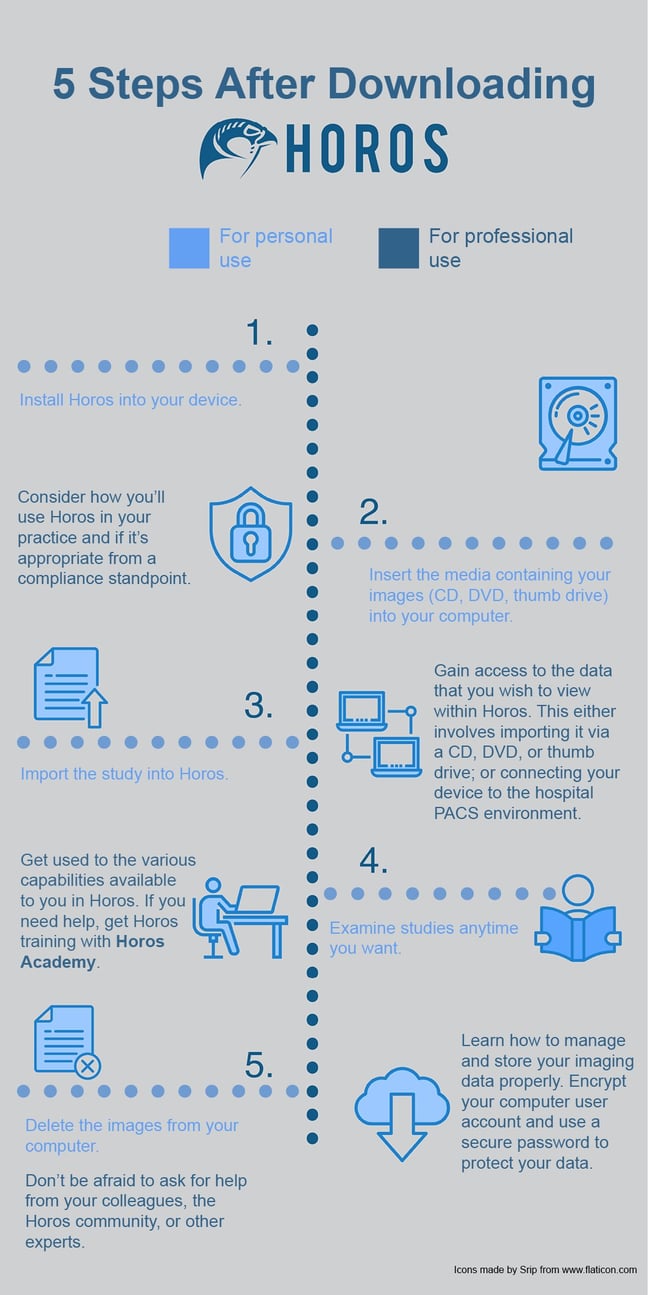

Horos, a free open-source DICOM medical imaging viewer for Apple computers, has been adopted globally by tens of thousands of diverse users, from clinicians and academic researchers to lawyers and patients who want to view their medical images.
As such, after downloading Horos the next steps you should take depend on the reasons you downloaded the software in the first place.
So what are the most common use cases for Horos, and what should you do in each instance?
Personal Use
Patients or others using Horos who only need to view their medical images and do not need to share them with a doctor or store them long-term, have a rather straightforward path after downloading the software:
- Install Horos.
- Insert the media containing your images (CD, DVD, thumb drive) into your computer.
- Import the study into Horos.
- Examine the study at your leisure.
- Delete the images from your computer.
This last step is particularly important, since you don't want to keep private health information unprotected on your computer due to security concerns. Make sure that the images have been completely deleted and that the media is stored in a safe place.
Professional Use
Clinicians and others seeking to use Horos in a professional setting, on the other hand, have more complicated considerations at stake, including compliance and data security.
- Consider how you'll use Horos in your practice and determine if it's appropriate from a compliance standpoint. If you work within a health care system and install a medical image viewer on your device, you need to be confident that your IT department and other stakeholders won't have an issue with you potentially storing protected health information (PHI) on your local hard drive. Using Horos in a clinical setting, especially in a diagnostic capacity, can present issues.
For example, radiologists in the United States practicing at an accredited hospital need to use software approved by the FDA. However, private practice doctors in many parts of the world who just want to use Horos to review an imaging study in the context of their patient's treatment may have fewer legal worries. If you're uncertain about how your local laws apply to your situation, it's always a good idea to consult with your legal counsel. - Gain access to the data that you wish to view within Horos. This either involves importing it via a CD, DVD or thumb drive, or connecting your device to the hospital PACS environment.
- Get acclimated with the various capabilities available to you in Horos. Experiment with altering the view using tools like magnification, contrast, window/level, invert, MIP/MPR techniques and 3D volume rendering.
- Learn how to manage and store your imaging data properly. Horos has a local database that you can search, as well as tools that allow you to create albums based on certain shared traits and categories. Be sensitive to how you manage your local data: Encrypt your user account on your computer and enable password protection with a secure password. This will ensure that your data isn't exposed even if your device is stolen. However, if you use a cloud-based service in which images are stored online and accessed via the internet, you don't have to worry about this.
- Don't be afraid to ask for help from your colleagues, the Horos community or other experts. The field of medical imaging is hardly easy, and even those with years and years of relevant experience will encounter challenges and roadblocks. With tens of thousands of Horos users worldwide, its likely someone else has experienced the same challenges and may be able to help you in the Horos user forum. We are also always here to help with any questions you might have.
Final Thought
Your first steps after downloading Horos will depend on what you want to use it for. However, whether you're a medical expert, a patient or a third party, it's essential to take precautions to guard against data loss and HIPAA violations.
Make sure that any data stored locally is password-protected and encrypted, and deleted when you have no further use for it. If secure, long-term storage is what you need, however, you may want to consider integrating Horos with a cloud image management solution.
Going forward, if you need help learning how to use the major functions in Horos, check out Horos Academy. This four-part video tutorial teaches how to use simple key features like uploading DICOM files to the more complex functions like 3D Rendering. You may also find the Horos User Guide to be a helpful tool. With more than 300 pages of instructions, this reference is a great source for finding answers to any questions you might have about Horos functions.
If you have more specific questions or need additional support, try the Horos Project Google Group Forum or you can purchase one-to-one technical support from a Horos expert.




